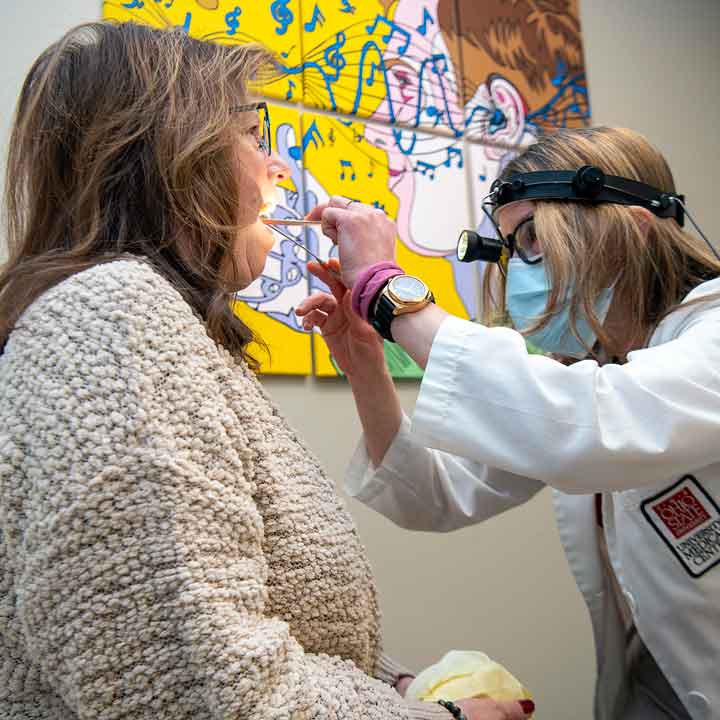 Breathing, speaking and eating are very important actions you perform daily without much thought. They’re also all related since they all use the throat.
Breathing, speaking and eating are very important actions you perform daily without much thought. They’re also all related since they all use the throat.
When you have an issue with one or more of those functions, it can have a tremendous impact on your quality of life, especially if it causes dyspnea, or shortness of breath.
Shortness of breath or difficulty breathing typically occurs because of lung or heart conditions, but sometimes dyspnea is caused by a voice and swallowing disorder. If your dyspnea is caused by one of these disorders, such as vocal paralysis or a mass in your throat, the voice and swallowing experts at The Ohio State University Wexner Medical Center in Columbus, Ohio, have specialized training to help heal these issues.
Often, we’re able to restore airway functions completely using medications, therapies, in-office procedures or surgeries; however, surgery is always a last resort for our specialists, who are part of one of the largest voice and swallowing centers in the country.
What is dyspnea?
Dyspnea is defined as shortness of breath or labored breathing. Your chest might tighten up and you feel like you can’t take a deep breath, catch your breath or get enough air into your lungs.
It’s typically the symptom of an acute situation (strenuous exercise, high altitude, allergic reaction, heart attack) or a chronic condition (emphysema, asthma, obesity).
Causes of dyspnea
While most causes of shortness of breath are linked to heart or lung conditions, in some cases difficulty breathing is a symptom of a voice and swallowing disorder or other airway obstruction. Examples of conditions that cause dyspnea related to the throat include:
- Vocal paralysis
- Aspiration (breathing in of food due to loss of muscle control from a stroke, for instance)
- Loss of throat sensation due to a tumor
- Growth of tissue mass
- Zenker’s diverticulum (a pouch formation in the base of the throat where food and liquid collect)
- Neurological dysfunction from amyotrophic lateral sclerosis (ALS), Parkinson’s disease, myasthenia gravis or other disorder
- Epiglottitis (swelling of the “lid” of the windpipe)
- Physical abnormality, like esophageal narrowing, that’s inherited or caused by trauma
- Scarring from injury or surgery
Also, as you age you may experience more swallowing and breathing problems. In fact, 50% of seniors have some form of swallowing dysfunction because of decreased sensitivity and muscle control or strength in the throat.
Dyspnea symptoms
Shortness of breath is the main symptom of dyspnea, but if your condition is caused by a voice or swallowing issue, you might also experience these symptoms:
- Chest pains or tightness in chest
- Sore throat
- Coughing or wheezing
- Hoarseness or weak voice
- Vocal paralysis
- Difficulty swallowing
- Weight loss
Difficulty Breathing Tests
Before proper treatment can be prescribed, we must figure out exactly what’s causing your symptoms. There are a number of tests to help determine the cause of the voice and swallowing disorder responsible for your shortness of breath. After a review of medical history, we might perform these tests:
- Fiberoptic endoscopic evaluation of swallowing (FEES) – examination of the throat with a scope while eating and drinking to assess swallow function
- Flexible laryngoscopy – examination of the throat with a telescope
- Esophagram – examination of the integrity of the throat and esophagus while swallowing contrast barium fluid that produces images of the affected area
- Imaging, including MRI or CT scan
- Modified barium swallow – observation of swallowing while you eat different foods coated with barium
Difficulty breathing treatments caused by voice and swallowing disorders
Treatment is tailored to each patient based on the results of testing. If your breathing issues are more acute and less serious, we might take a more conservative approach using these treatment methods:
- Diet modification
- Medications
- Therapy, including swallowing and speech
More serious conditions can be treated accordingly:
- Feeding tube insertion for aspiration problems
- Surgery to remove abnormal tissue growth, dilate the esophagus or remove the pouch from Zenker’s diverticulum
- Tracheostomy tube placement in the trachea to allow proper breathing temporarily until underlying obstruction or problem is corrected
Additional Information
How would you like to schedule?
Don’t have MyChart? Create an account
